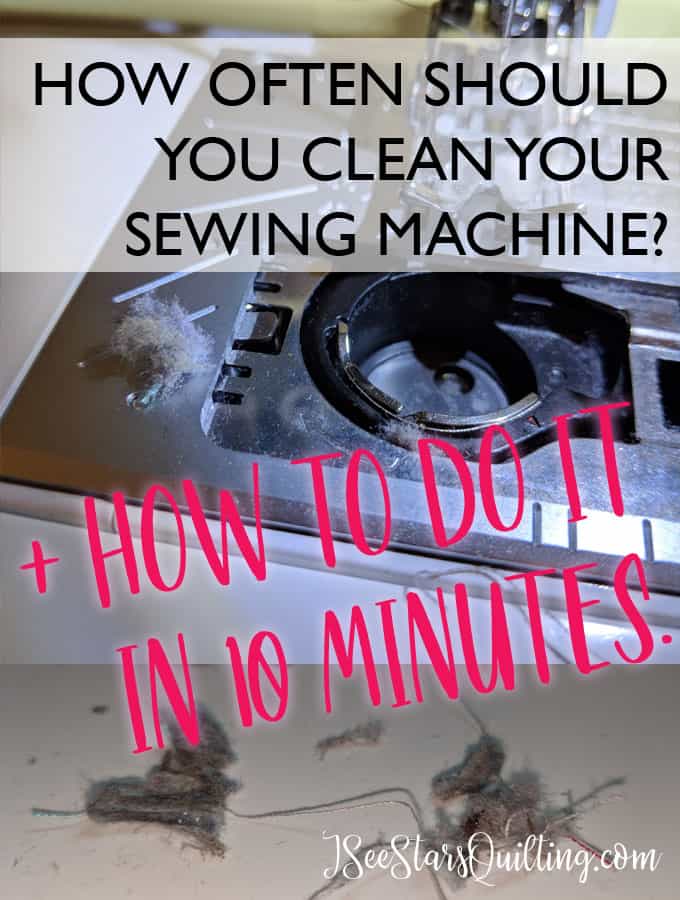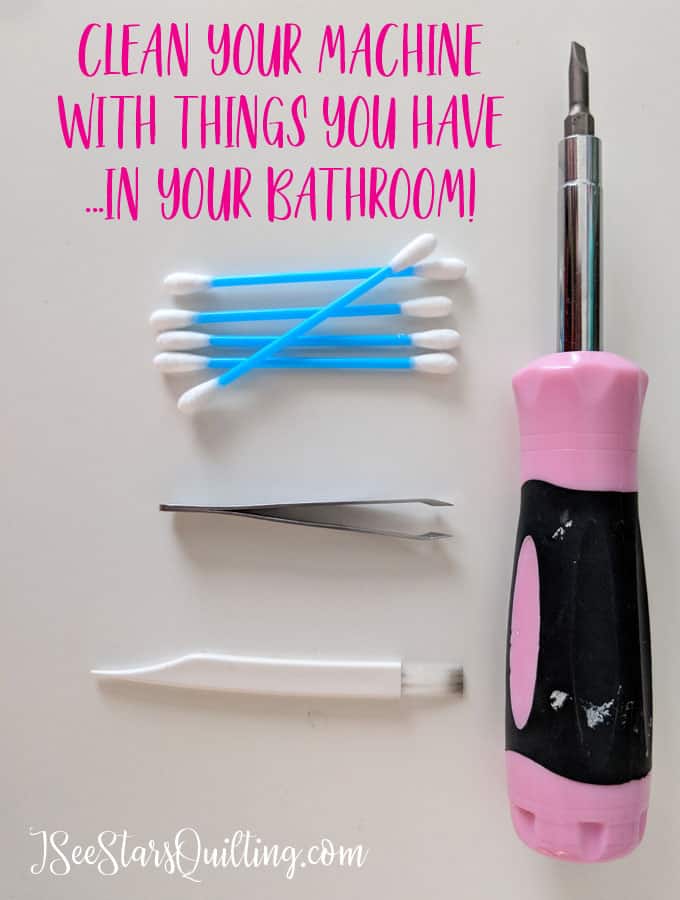Whether you just purchased a brand new sewing machine or you’ve had yours for a while, eventually the question is bound to come up… “How much does it cost to get my sewing machine serviced?” and “Do I need it? How often should I go?”
The recommended answer is that you should take your machine in about once a year to have it serviced. However, my experience is that you can go a little longer to stretch those services out a little bit more.
With good in between care done by YOU, using some of the tips I’ve outlined below… you can stretch it into about every 2 years as long as everything is running smoothly.
Obviously if you notice something is off or there is a weird noise that you didn’t notice before… PLEASE take your machine to have a good once-over by a professional shop.
A lot of quilter and sew-ists like to think of it as a luxury spa day for their machines! ooh-la-la!

How much does it cost to get my sewing machine serviced?
A sewing machine tune-up costs can vary according to each shop, but general cost ranges are in the $75 to $100 Range. These charges will not include the cost of any broken or replacement parts.
Computerized embroidery machines may cost as much as $100 for basic repairs.
Before you put away your wallet and decide to just start saving up for your next sewing machine… we’re going to go over exactly what a sewing machine service entails, why your machine needs it (no, its not a hoax) and if you can save the money and perform the service yourself… AND a few little things you can do throughout the year to stretch your money a little further!
Why Service a sewing machine?
There are many many many moving parts to a sewing machine.
If it moves, it needs lubrication to avoid wear and tear.
As a sewing machine is used, the lubrication eventually dries out. Once it has dried out, moving parts don’t work as well. The well being of the sewing machine starts to wear out faster than if it was maintained on a regular basis.
Most new sewing machines are making the move toward higher-tech machinery. Your machine may have a computer circuit board and wires inside as well. Sewing machine technicians are specially trained to maintain and service computerized sewing machines. Unless you know exactly what you are doing, it isn’t recommended to ‘go inside’ and do anything yourself. A circuit board can easily fry at the hands of a well-meaning but clueless soul.
A yearly service will prevent any heavily worn areas to be caught before they cause a worse problem down the road.
Most machines do not need major replacement of parts when preventative maintenance is scheduled.
Case in point: You machine should be serviced to keep it running smoothly for a long long time.
Just like our bodies, teeth and car receive yearly check-ups, make sure your sewing machine receives equal treatment!
What is done during a sewing machine service?
The short answer? A WHOLE LOT!
A full service isn’t just a quick in and out. Technicians will have a long checklist of items to carefully go over as they take a look at your machine.
Here is an example of the checklist performed during a routine service:
- Remove all covers to get to all major components.
- Clean out all lint, dust, and old old oil.
- Remove stray threads from the take-up lever and the hand wheel.
- Check top tension disks and remove lint build up from low-quality threads.
- Check timing belt/motor belt for belt tightness. Look for any excess wear spots.
- For older machines: check motor brushes and make sure the motor is turning freely.
- Check all shafts for any play or wobble.
- The wear of all barrings.
- Check the mechanism that drives the feed dogs for any play.
- Double Check all gears that drive the machine.
- Check the mechanism that drives the hook in the bobbin case area.
- Check for any excess play between the hook and the hook driver.
- Tighten any gears that are getting loose or wobbly.
- Check bobbin winder.
- Check feed dog height. A slight change in height could affect the way fabric is pulled through the machine.
- Check feed dog alignment checking to make sure the feed dogs are straight and not rubbing on the stitch plate.
- Oil every moving part of the machine.
- Check that the needle is centering in the needle plate both from side to side and from front to back. The slightest bit off in any of the four directions can cause extra needle breakage when sewing extra wide stitches or heavy fabrics.
- Check needle and hook timing.
- Check that the presser foot sits straight on the feed dogs and is at the proper height.
- Time the feed dog movement to the machine needle.
- Calibrate bobbin case tension.
- Check and clean bobbin case of any excess build up of lint.
- Check foot control’s electronic contacts, cord, cord end and look for any cuts in the cord.
- Test Sew Out – Once all areas of the machine have been completely checked, oiled and adjusted, the tech will do a test sew. Ideally, they are looking for a smooth running sound, balanced tension, even needle swing, centered needle position, proper feed dog movement/balance of stitches that stitch forward and reverse.
- They will also insert a new Universal size 80/12 needle.

What to bring with a machine for service?
This list is pretty simple and straight forward. You’ll want to bring:
- Your sewing machine
- Foot Pedal Control
- Power cord
- Standard zig-zag presser foot (not a 1/4 inch foot)
- Correct bobbin
- If bringing an embroidery machine, also include an embroidery hoop and the embroidery foot.
You shouldn’t only take care of your machine once a year, however… careful care should be considered every single time you sew.
I take my machines once every 2 years. Another quilter may tell you a different amount of time. You just have to find the comfortable medium between how your machine is acting and what your wallet can handle.

Can I perform a Sewing Machine Service myself to save money?
There are a lot of videos on YouTube that instructs you how to service your own machine. I recommend giving them a good look before you just open up your machine and taking things apart…
Personally, I very much suggest doing as much of the maintenance yourself on your machine as possible. This can stretch the time in between your services and make sure that things are running smoothly in between. You can read more about cleaning your machine in this post.
If you use your sewing machine to sew (duh…)… you MUST clean it!
Fabrics are linty, some threads are linty and that all leads to moving parts moving not so freely. Uncleaned machines lead directly to skipped stitches, uneven stitches, and broken threads right in the middle of a seam.
It is an awful mess to be in when you’re nearing the end of a project and have to stop!
You can see a full tutorial on a Quick 10-Minute Sewing Machine Cleaning in this post!

You might think that a little sewing here or there won’t leave much of a mess inside your machine, but you would be completely wrong!
Soft minky fabric is the worst for causing all kinds of lint buildup after just a few minutes of sewing.
After each project that you sew, take a few minutes to open up your machine and empty out the lint and any thread fuzz. You’ll thank me later 😉
Where should I take my machine to have it serviced??
The best thing to do is to call around and find a place that does not have to ship/take your machine off-sit to be serviced.
Most vacuum and sewing machine stores will have technicians on site to work on your machine.
If a shop sends your machine off to be serviced, you will be looking at a longer turn around time.
You can also call your local small business quilting shop and see where they recommend or where they take their own machines. Big box stores will not be able to send you anywhere.
What questions should I ask when I drop off my sewing machine?
Make sure that the terms are very clear when you drop off your machine.
- How long should I expect to be without my machine?
- Do you do the service on site?
- What is the cost of a tune-up?
- If my machine is in need of repairs, will someone contact me BEFORE ordering parts? – The last thing you want is a surprise bill at the end of your service for parts you didn’t know were in need of repairs!
- Do you offer any type of discount if I bring in multiple machines at one time?
Whew! I know that was a lot to digest but hopefully, you’ve learned a thing or two and I have completely answered your question, “How much does it cost to get my sewing machine serviced?”… and then some because I’m totally about providing the extra information that you need to know!
How much does it cost to have your machine serviced where you live?

My sewing machine broke down, and I’m not sure what to do about it. It makes sense that I would want to get a professional to fix it for me! I’ll make sure that I have it serviced from then on, too. That way, I don’t have to worry about it breaking down again any time soon.
It really is a mind shift… As DIYers and Crafters, in my experience, we all think that we can fix anything on our own! “How many pieces of tape is this going to take?” LOL BUt it is always better, in the long run, to fork over the service fee than it is to have to buy a new machine. IF you’re in the market for a new machine, I have a post with the best deals on Amazon. https://iseestarsquilting.com/the-best-sewing-machine-deals-on-amazon/ Good luck with your machine!